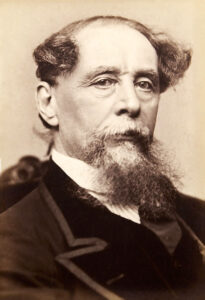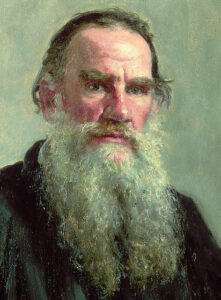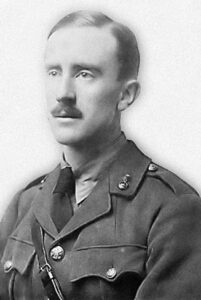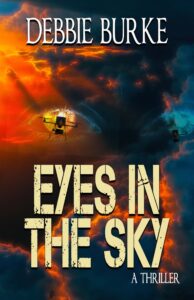
Photo credit: JohnPotter Pixabay
By Debbie Burke
Why does a writer choose to tell a story from a particular point of view?
Recently, Chuck, a regular TKZ reader, emailed me with questions about omniscient point of view. He wanted to write the first chapter of his revenge-theme murder mystery from the omniscient POV.
Right away, I knew I wasn’t qualified to advise him. I’ve never written anything omniscient. The books I read rarely use it because my personal taste has always favored close, intimate POVs.
So I dove down the research rabbit hole to learn more about this mysterious POV.
Masterclass.com offers this definition:
An omniscient narrator is all-seeing and all-knowing…The narrator may occasionally access the consciousness of a few or many different characters.
Some writers use this perspective to create a more “godlike” or deliberately “authorial” persona that allows them to comment on the action with the benefit of distance.
Before TV, films, internet, and streaming, most people didn’t venture far from the places they were born. Travel was the domain of the wealthy.

Charles Dickens – Wikimedia
Therefore, books were ships that carried readers to distant shores they would never personally set foot on; to exotic worlds constructed from the author’s descriptions; to smells, sights, sounds, textures, and tastes readers could only imagine.
World building was crucial.

Leo Tolstoy – CC BY-SA 3.0
Authors like Dickens, Tolstoy, and Tolkien spent many pages explaining the physical, social, religious, economic, historic, and psychological elements of the story world.

J.R.R. Tolkien – public domain
But as communication increased and the world became smaller, authors no longer had to paint such detailed pictures.
Reader interest shifted to characters who were fascinating or with whom readers could identify. They wanted go deeper into the characters’ hearts and minds to vicariously experience their fears, elation, rage, joy, doubt, guilt, pride, disappointment, lust, etc.
In today’s book market, close third and first person POVs are the most prevalent, although epic fantasy with its detailed world building still uses omniscient POV.
According to a 2016 New York Times article by Elliott Holt:
The effects of omniscience are authority and scope; novels with such narrators seem especially confident. The characters may be uncertain, but we sense the controlling force above them. Omniscience reinforces that we are reading fiction.
Some readers like that quality while others see it as authorial intrusion.
Holt goes on to say:
We know we’re being watched, by traffic and security cameras, by our employers, by the N.S.A., by random people taking pictures with their phones. We’re aware of the threat of hackers and cybercrime…Technological transcendence is “spooky”: Perhaps omniscience taps into this collective fear about loss of privacy.
Hmm. That explains why I personally avoid omniscient POV.
The most comprehensive article I found about omniscient POV is by John Matthew Fox of Book Fox at this link.
John provides clear, understandable explanations. For instance, in discussing show vs. tell, he says:
Third person omniscient is often more telling than showing, because the narrator is an objective observer. It’s like you’re telling someone about a movie you just saw.
He defines two types of third-person omniscient POV:
Objective: The narrator knows all, but they’re an observer. They can’t get into the characters’ heads, but are telling the story from somewhere outside.
Subjective: The narrator is an observer with opinions. We get a sense of what the narrator thinks about every character, in a judgy kind of way.
He says one advantage is the narrator “can dispense information that no character knows.” But he cautions: “many writers slide over into head hopping.”
He goes on to elaborate:
Where this gets confusing, especially for new writers, is in third person omniscient. Some newer writers think that head hopping and third person omniscient are the same thing, or at least close. This is not true. Third person omniscient tells a story from one perspective: the narrator’s. The narrator shouldn’t tell us the thoughts and feelings of all the characters, or any of the characters.
The narrator shows us how the characters feel through action and dialogue, not by hopping into the character’s heads to reveal what they’re thinking. The story is told from the narrator’s perspective, like the narrator is a character.
Here is John’s most compelling argument against using omniscient POV:
Literary agents and publishers are so reluctant to consider third person omniscient, and they’re not going to do it for a new writer. If you really want to try third person omniscient, do it for a very limited time, like the first chapter, to describe the setting. Sort of like a wide shot in a movie, writing the first chapter in third person omniscient can work.
~~~
As writers, we like to experiment with new ways to tell stories. Some experiments work, others fall flat, and a few explode in our faces.
After researching, my suggestions to Chuck are:
Examine your motive for using omniscient. Why is it the absolute best way to introduce your story? If it’s merely a gimmick or experiment, rethink the choice.
Run the first chapter by critiquers and beta readers. They’ll help you judge if it works or not.
Before submitting to agents or editors, understand that many are predisposed to dislike it.
If you use omniscient POV, be darn sure it’s done correctly and effectively.
~~~
TKZers: Please share books you’ve read that use omniscient POV. Which work and which don’t?
Why do you like or dislike omniscient POV?
~~~

In Debbie Burke’s thriller Eyes in the Sky, a drone gives an omniscient–and sinister–point of view. Please check it out at these links:

The first one that comes to mind that I’ve read is the Tale of Two Cities. I loved that book and think the omniscient POV was effective, especially for its sort of historical tone, but then Dickens was a master storyteller, so…
TL, <iTale of Two Cities is the perfect example.
Editors often tell writers never to start a sentence with “It was” or “There was.” Yet…
“It was the best of times, it was the worst of times…” remains one of the best, most famous, most quoted first lines ever.
Dickens endures. But do you think he could get published today?
Debbie,
I do think Dickens could get published today because his deft handling of plot and memorable character sketches such as Madam Defarge, Oliver Twist, David Copperfield, Pip and Estella result in satisfying stories. Yes, his style reflects the style and appetite of his time period and place, mid-nineteenth century British literature, and if he were writing today, I think his style would reflect contemporary social mores and character types.
Debbie, I just finished The Mirror Man by Lars Kepler. Kepler (a pseudonym for a husband/wife writing team) favors omniscient POV told in the present tense. They use this pairing to maximum effect in their novels, which concern police procedures dealing with bizarre and very violent crimes. The suspense level is so high that at times I am torn between tearing through the book or setting it aside just to tap the brakes. My favorite books generally are those where I have no idea what will happen next and the Kepler collective consistently provides that.
Notwithstanding the foregoing, that doesn’t mean that I won’t pick up a book that utilizes another POV. Presumed Innocent is my go-to book for a first-person (present) narrative that works incredibly well.
The photo at the top of your post this morning is an excellent representation of the writer’s task of picking who tells the story. I honestly think that most casual readers don’t notice the process…unless it doesn’t work. Then there is a problem.
Thanks for yet another great and thought-provoking post, Debbie. Enjoy your day!
Thanks for the Lars Kepler example, Joe. Your enthusiastic recommendation sent me straight to Amazon to check out The Mirror Man, only to find it won’t be released until 2022. Drat! Lucky you to get a sneak peek.
I did read a sample from one of Kepler’s other books and I see what you mean. Although omniscient feels awkward and clunky at times, Kepler’s storytelling is compelling and chilling.
And that’s what it’s all about, no matter whose POV the author chooses.
Have a great day!
Omniscient POV has a range of what MFA profs call “Narratorial Prominence.” It can be “editorial” (as in Dickens) or “neutral” (as in Hammett); it can be “selective” (focus on one character throughout, including inside the head) or “multiple” (inside any head at any time).
In answer to Chuck’s question, writing a first chapter of a mystery in omniscient style is perfectly acceptable and can be effective. Lawrence Block’s A Walk Among the Tombstones opens Omni then drops into First.
Great advice, Jim. Thanks for the explanation of narratorial prominence.
I don’t know how an automatic transmission works and don’t care as long as the car drives fine. But POV is an under-the-hood concern for writers who want to learn the subtle inner workings and fine points of the craft.
Most readers don’t care about POV, as long as the story engages them.
Great post, Debbie. Thanks for the discussion and the link to Book Fox.
I like Dickens’ use of omniscient. Many of the other classics make me grow impatient or bored.
What I like most about omniscient is the cinematic technique of starting with a wide angle view, then gradually focusing in – “Sort of like a wide shot in a movie, writing the first chapter in third person omniscient can work.” – used in a short first chapter to set the place, the mood, and the broader situation, then focus in to the story and protagonist. It is like getting your bearings before you jump into the fray. When movies start with slam-bam fast paced action, I’m often missing things while I try to figure out where I am and what is going on. That’s just my preference.
Thanks for the topic and discussion. Have a great day!
Thanks for your thoughts, Steve. I too like the wide-angle bird’s eye view to get your bearings before a story begins. Cinema offer all kinds of techniques that are useful to writers.
Great post, Debbie. Years ago I took a writers workshop from David Morrell. He touched on the omniscient POV, and noted that it could be used to good effect in the opening of a novel, before you zoomed into the 3rd person POV of a particular character. He mentioned his own novel First Bloodas an example. An almost cinematic POV that then becomes 3rd person. I was fascinated by that, though I’ve never written a book in omniscient, and likely never will.
The classic science fiction novel Dune employs omniscient to handle its sweeping narrative and it works. You still find omniscient in SF these days, but a multiple set 3rd person POVs is more likely, as in The Expanse. Personally, I prefer the immersion the latter can provide 🙂
Have a great day!
Sounds like a terrific workshop, Dale. I would have loved to hear that.
The consensus appears in favor of an omniscient first chapter to set the stage before delving deeply into a closer POV.
Good morning, Debbie. You said something in one of your comments that resonated with me:
“Most readers don’t care about POV, as long as the story engages them.”
I agree with that statement. “Pride and Prejudice” is just one example of an engaging story told by an omniscient narrator. Also, Agatha Christie used a variety of POV techniques in her work, and she managed to sell a few books. 🙂
I’ve read some others (M.C. Beaton comes to mind) who were head-hopping all over the page, but the stories were fun to read.
Kay, I was fortunate to meet the delightful M.C. Beaton shortly before she died when she autographed The Witches’ Tree for me. I remember the head-hopping bothered me a little at first but pretty soon she’d sucked me so deeply into the story, I no longer paid attention.
Lucky you to meet Ms. Beaton! I think I noticed the head-hopping only because I was told not to do it by my editor. Like you, I became so engaged in the story that I no longer paid attention to anything else.
Good morning, Debbie, and good topic. I have no problem with omniscient POV. Two prominent writers immediately come to mind who mastered the technique – Frederick Forsyth and Tom Clancy. Their ability to tell the story and captivate the reader are outstanding.
BTW – there’s a wrench in the KZ WordPress spokes. I could access this post via your Twitter link but not from the KZ home page. It’s been doing this for some time now, and I can only get the current post a day or two after it’s published.
Garry, thanks for adding Clancy and Forsyth to the discussion.
I too have been experiencing difficulties with the RSS feed. Clare’s post from yesterday didn’t arrive until this alm., together with mine for today.
From time to time, those darn WordPress gremlins get rowdy. I’ll contact our webmaster Lynne who always slaps them into submission.
Good morning.
A while back I read Red October, which was on my list to read since I really like Tom Clancy Movies. Anyway, hated the book. The “head hopping” was too much. It took me a while to get used to it, since I had been training myself not to do that. Sometimes when I read I run over those speed bumps, HARD, just because I’m trying to adapt my own writing in a certain way.
Makes me think that I’m just conditioned now to not appreciate or accept it. The story was pretty good, but I couldn’t immerse myself in that style of writing.
BTW – Loved the article and the perspective. Also, the cold snap that going south from Calgary to Montana is not my fault.
Ben, 22 degrees F (-5 C) in Montana this a.m. We’ll forgive Calgary this time but don’t let it happen again. 😉
Personal preference and conditioning play roles in how much a reader likes or dislikes a particular POV style. Raymond Chandler’s first person POV was a big influence on me. If I’d fallen in love with Pride and Prejudice or The Hobbit instead, I’m might be more disposed to omni.
Unless a writer is truly skillful, POV experiments can turn into big speed bumps.
For starters, I think people trip over the word “omniscient.” Suppose one your the decisions you’ve made as an author is to write your pack of lies as if they’re all true.
An accurately told third-person true story has an author who knows all about the story (perhaps by interviewing all the survivors and visiting all the locations) and is thus prepared to tell the story with confidence, including the use of what people were thinking at the time. That’s not omniscience, that’s research, with some poetic license and supposition-presented-as-truth thrown in. A novel written this way gets the extra oomph of being written as if it were true. Since true stories can be told anywhere on the spectrum from seemingly objective to highly opinionated, you can be as lofty or as Lemony-Snicketty as you like. That’s third-person omniscient in its “lies camouflaged as truth” guise.
None of this keeps the author from twisting the narrative-distance dial according to the needs of the moment, and it can be as distant or as intimate as the author dares make it in any given paragraph.
The equivalent first-person mode is a story framed explicitly as a true story told by a participant. When someone is telling a real-life experience to an audience who isn’t familiar with the setting, they help the reader as a matter of course via exposition. The pretense that the story is telling itself, without a narrator, as if it were a lightly edited brainwave recording, is not used by humans when telling true stories, so for verisimilitude, this kind of first-person doesn’t do it, either.
So I use third-person omniscient with one hand on the narrative-distance dial whenever my narrator is a better storyteller than my main character (which never happens, because I loathe inarticulate protagonists).
Love your twisting of the narrative-distance dial, Robert!
These days, people have so many ways to entertain themselves that reading has a hard time even being considered, let alone being in the top five of how someone wants to spend their down time and money. As writers, we have to figure out why our stories should be part of that down time. What does reading this story give that no other entertainment gives?
Science has helped here by studying the brain activity of readers. “Being there” is what readers want. They want to be in the story and feel, see, taste and sense through character viewpoint. The character’s reactions make our brains experience the same thing, and this makes the brain and reader very happy. Omniscient viewpoint’s main target is the intellect which works for some readers, but it doesn’t offer those wonderful I’m-there brain reactions a majority want.
Another reason not to use omniscient is that newer writers suck at it, every single time. It’s a landscape of bad craft land mines that the ignorant writer skips happily through, blissfully unaware that the reader experience is being destroyed in his path. Once the craft is master level after years of writing and the writer reaches excellence, he may decide omniscient POV should be tried. Even then, he’ll probably start a few chapters then go “Hell, no. This is tripe.” End of omniscient experience.
As a writing teacher, I’m guessing that the real reason Chuck wants that first chapter as omniscient is he wants to info dump all his worldbuilding in one spot because he thinks the reader needs this pile of worldbuilding vomit NOW. Spoiler alert: They don’t.
So, listen to agents, editors, other authors, writing teachers, and readers, and just so no to omniscient.
As a side note, one of my minor regrets as a writer is I’ve never broken the omniscient fourth wall and said in true Thackeray VANITY FAIR fashion, “Do not despair, gentle reader. Becky will get her comeupance.”
Marylinn, you make an important distinction between reading for a vicarious emotional experience or reading for intellectual enrichment.
“What does reading this story give that no other entertainment gives?” — that’s a tough question that we writers should ask ourselves often.
Thanks for sharing your always-thoughtful perspective based on long experience as a writing instructor.
I like that question – “What does reading this story give that no other entertainment gives?” – I agree that we should be asking that question often, especially in light of all the choices the reader has.
“What does reading this story give that no other entertainment gives?”
Why not do it all? Write a story and license the adaptation rights…. TV series/movie… theatrical performance… merchandising… sky’s the limit.
I applaud your ambition, Harald. If only there was time and energy enough to do it all!
I just finished another Kerry Greenwood Miss Fisher mystery, Murder in the Dark. Definitely omniscient or head-hopping or something, and it doesn’t seem to have hurt Greenwood’s sales.
“The bell rang. Mr. Butler heard Dot get up from her seat at the kitchen table, where she and Mrs. Butler had been amiably shelling one hundred chestnuts for stuffing the Christmas goose.
“Removing two strongly adherent shells from the annoying nuts was a job best done in company. He heard Dot say, as she laid her chestnut down with a click, ‘That’s ninety-three, Mrs. Butler.’
“In her parlour, Phryne noted the approach of the jug of Pimm’s Number One Cup…. She liked the burned-sugar flavour of the gin-based cup….”
Lest it be asserted the Greenwood can “get away with this” because she’s already successful, let’s take a look at the first in the series, Cocaine Blues.
“The doorman unbent sufficiently to help this lovely aristocrat into a waiting cab….
“‘Ain’t she beautiful,’ sighed Dot, and the doorman agreed, reflecting again that the tastes of the aristocracy weren’t so odd after all. Indeed, Dorothy in her new uniform and her own shoes was very easy on the eye herself. Dot recollected herself, blushed, and retreated to Phryne’s room, to listen to the wireless playing dance music an to mend yet more stockings. Phryne usually bought new ones as soon as the old developed holes, and this extravagance shocked Dorothy profoundly. Besides, she liked mending stockings.
“Phryne leaned back and lit a cigarette. She was smoking Black Russian cigarillos with gold-leaf tips; not really as palatable as gaspers, but one must be elegant, whatever the sacrifice.”
So we’re in three heads in the space of less than three full paragraphs.
Louise Penny, in her first Gamache novel, Still Life, has no qualms about being in the head of whoever she feels is relevant to her story, even within the same scene and on the same page.
Wow, those are some busy paragraphs, Eric. If that didn’t distract from your enjoyment of the books, then it works.
I usually prefer close third person, or first person POV. But, like many others, if the story grabs me, I adjust.
I cut my teenage reader teeth on Agatha Christie, and I don’t ever remember being put off or confused by POV. (Of course, back then I didn’t know what that was, so…)
🙂
Great discussion, Debbie. As always, I got learned again.
Deb, my taste runs the same, first person or close third. The secret inner workings of a character’s mind are endlessly fascinating to me.
Dame Agatha has spoken to millions of enthusiastic fans for decades, none of whom cared a farthing for POV.
Thanks for adding to the discussion!
Great article. I’ve always stuck to third person close, Starting with an omniscient in the first chapter is an interesting idea. I’ll have to do a little exploring,.
Thanks, Brian. Your stories have a cinematic quality that might lend themselves well to a wide-angle opening shot.